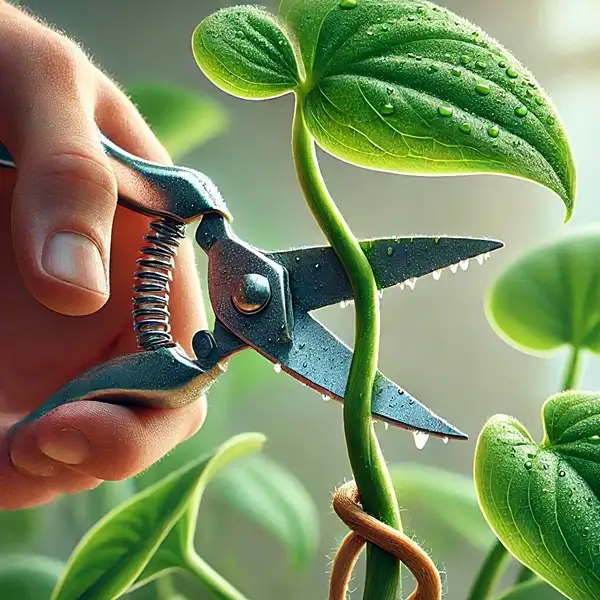Key Takeaways
| Key Takeaways |
|---|
| Discover the secret behind how pothos naturally grow and adapt indoors. |
| How to make pothos fuller? Uncover the best-kept strategies to achieve lush, fuller pothos. |
| Learn why pruning is the ultimate trick to transform your plant’s appearance. |
| Find out the most effective way to feed your pothos without overdoing it. |
| Unlock a simple yet powerful method to multiply your pothos effortlessly. |
| Avoid the most common mistakes that can secretly harm your plant’s growth. |
Understanding the Growth Patterns of Pothos
Pothos (or Epipremnum aureum) is a well-known houseplant treasured for its cascading vines & glossy heart-shaped leaves. It showcases a unique growth pattern that amazes any gardener. As nature designs it as an opportunistic climber in the wild, you will discover its long tendrils reaching out in search of something to cling to at home.
This fascinating green vine conveniently adapts to different light conditions but thrives remarkably better under moderate indirect light. Certain varieties such as Golden Pothos can exploit low-light settings while Marble Queen would rather bask in brighter indirect sunlight.

Interestingly, direction & speed of Pothos’ growth largely depend on factors like temperature, humidity & lighting conditions. Frequently exposing your plant to temperatures between 70-90°F along with high humidity levels will substantially boost its growth process.
Moreover, this indoor plant displays semi-succulent characteristics that tolerate dry conditions but prefers moisture-loving environments for optimal health & vigorous development.
5 Ideal Conditions for Fuller Pothos
Your desire for fuller pothos roots down to creating ideal growing conditions that replicate their natural tropical jungle habitat.
| Condition | Optimal Range | Notes |
|---|---|---|
| Light |
|
|
| Humidity |
|
|
| Temperature |
|
|
| Soil |
|
|
| Watering |
|
|
Importance of Pruning for Lush Pothos Plants

Pruning plays a critical role in nurturing bushier & fuller pothos plants.
- Regularly tending to your vines & trimming them back not only fosters thickness but also helps maintain control over otherwise invasive ivy-like growth.
- Each snip stimulates growth at node (where leaf meets stem) encouraging multiple shoots.
- Therefore, don’t be afraid to trim your vine ends back by a few inches. This will provoke healthful branching & lush foliage.
- The wonderfully beneficial aspect of pruning lies not merely in its ability to stimulate denser plant growth but also in its ability to identify any pest infestations or diseases early on, preempting bigger future troubles.
5 Expert Fertilizing Tips for Healthy Pothos
Feeding your indoor friend holds the key to lovely variegated leaves bursting with vitality!
| Aspect | Recommendation |
|---|---|
| Fertilizer Type |
|
| Frequency |
|
| Application Tips |
|
| Organic Options |
|
| Signs of Nutrient Deficiency |
|
2 Golden Tips
- Always Remember! Less is more when it comes to fertilizing – you’d rather avoid nutrient toxicity than starve them slightly.
- An effective fertilization strategy combines prudence with observation skills: making adjustments based on variegation intensity, growth rate & overall plant wellness yields healthier bushier pothos.

6 Easy Propagation Steps: Boost The Fullness Of Your Pothos
Pothos propagation proves an effortless process – even so, it dramatically enhances their fullness!
| Step | Description |
|---|---|
| 1 | Select Healthy Cuttings: Choose a vine with several nodes (points where leaves attach) & cut just below a node |
| 2 | Prepare the Cutting: Remove lower leaves, leaving at least one or two leaves at top |
| 3 | Rooting Medium: Place cutting in water, ensuring nodes are submerged or plant directly into moist potting mix |
| 4 | Root Development: In water, roots typically develop within 2-4 weeks. In soil, gently tug the cutting after 4-6 weeks to check for resistance, which indicates root growth
This method allows you to double your plant without investing in more pothos from store! |
| 5 | Transplanting: Once roots are established (about 1 to 2 inches long), transplant cuttings into soil |
| 6 | Enhancing Fullness: Plant multiple cuttings together in one pot to create a bushier appearance |
5 Mistakes to Avoid for a Lush, Full Pothos
Avoid succumbing to typical errors while caring for lush, lavish pothos.
| Mistake | Consequence | Prevention |
|---|---|---|
| Overwatering |
|
|
| Direct Sunlight |
|
|
| Over-fertilization |
|
|
| Low Humidity |
|
|
| Insufficient Light |
|
|
Enjoy a Fuller, Healthier Indoor Pothos
With these essential guiding tips at hand, you are bound to enjoy beautiful, bushy Pothos indoors. They are not merely an aesthetic visual treat but also serve as silent nature companions.
Pothos help harmonize living environments with soothing, peaceful energy vibes!
Frequently Asked Questions
How to make pothos climb?
Provide a moss pole, trellis or wall hooks for support. Secure vines loosely with ties & place them in bright indirect light.
Why does my pothos only have one vine?
Lack of pruning prevents branching. Trim tip to encourage multiple shoots. Ensure proper lighting & nutrients for balanced growth. Plant additional cuttings in same pot for fullness.
Why is my pothos skinny?
Insufficient light causes leggy growth. Move it to a brighter spot & prune regularly to promote thicker stems.
How do you make pothos more bushy?
Trim long vines to encourage lateral growth. Propagate cuttings & plant them together. Maintain high humidity & provide bright, filtered light for dense foliage.
How do you prune pothos for fullness?
Cut just above a node to stimulate new shoots. Remove weak stems & propagate cuttings in same pot for instant volume.
Do pothos like to be crowded?
Mild root crowding boosts fullness but extreme crowding stunts growth.








